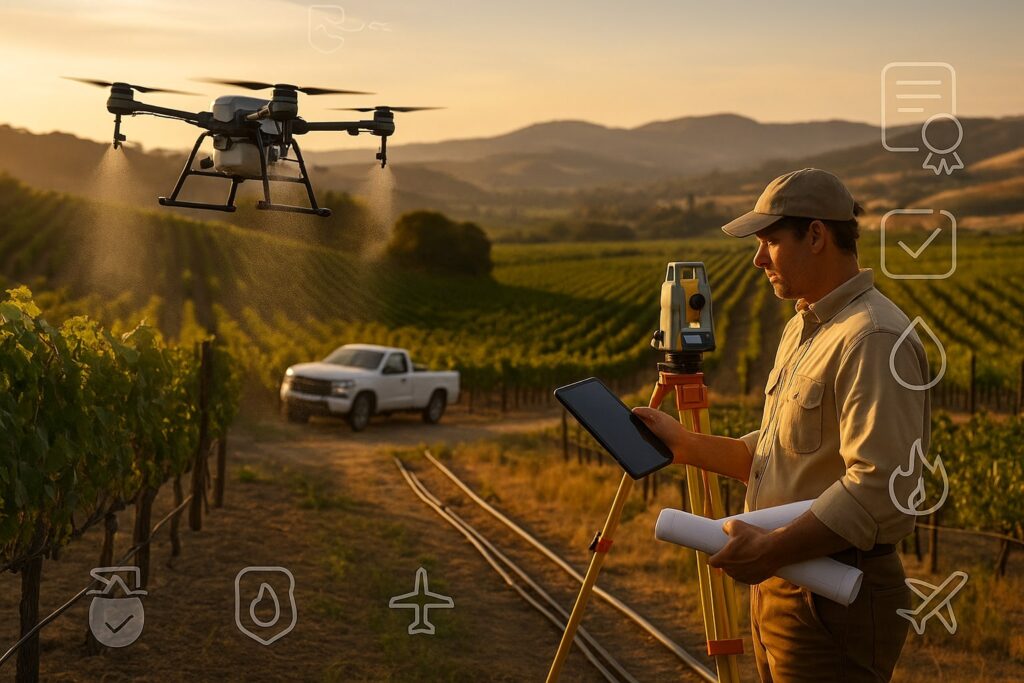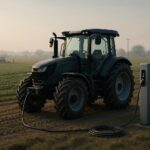ZenaTech’s acquisition of Lescure Engineers is more than another roll-up. It’s an experiment in whether growers will rent precision tools—and the compliance burden that comes with them—rather than own them outright.
On September 11, ZenaTech said it would acquire Lescure Engineers, a Santa Rosa–based civil engineering and land-surveying firm that has worked in North Bay wine country since 1979. The deal, expected to close on September 12, gives the Nasdaq-listed drone company a ready-made customer base in Sonoma and Napa—and a beachhead to sell a menu of Drone-as-a-Service (DaaS) offerings from aerial imaging and irrigation analytics to precision spraying and wildfire monitoring. It’s ZenaTech’s ninth U.S. acquisition on the way to a stated goal of 25 DaaS locations by mid-next year.
Lescure is a sensible on-ramp: it advises wineries and developers on grading, erosion control, water and wastewater systems, and permitting—work that already touches the data layers drones can enrich. Its public materials underscore long tenure in the Sonoma–Marin–Napa counties, the core of U.S. fine-wine agriculture.
Table of Contents
ToggleWhy this market—and why now
California remains the country’s agricultural heavyweight. Farm cash receipts in 2024 were about $61.2 billion, roughly 12% of the U.S. total, with grapes a marquee specialty crop. Concentrating drone services in Napa–Sonoma is therefore less a niche play than a targeted strike on the highest-value corners of specialty agriculture.
Local economics help the thesis. Sonoma County’s newly released 2024 crop report pegs agricultural value at $857.6 million, with winegrapes contributing $626.5 million (≈73%)—a single, data-rich crop where canopy vigor, water stress and disease pressure swing both quality and price. Napa’s 2024 harvest produced 147,182 tons off 45,967 bearing acres, worth just over $1 billion; the county’s average price per ton—north of $7,000—keeps growers laser-focused on tools that protect quality.
The bundle ZenaTech is really selling: outcomes—plus compliance
ZenaTech’s pitch is classic OPEX over CAPEX: on-demand flights, analytics and operations without buying hardware, training pilots or navigating permits. That last clause matters. In the U.S., spray operations sit under FAA Part 137 and often require a Section 44807 exemption for heavier platforms; operators must file FAA Form 8710-3 to certify and, in California, also secure state pesticide aircraft pilot certification and county-level permits. Many vineyard managers who already juggle water, labor and wildfire risk would welcome outsourcing that tangle.
Put differently: selling drones is hard; selling acre-level outcomes—“find me the thirsty blocks, spray precisely on Tuesday, document it for auditors”—is easier. ZenaTech says the DaaS roster will cover imaging, precision spraying, irrigation analytics and wildfire monitoring—all high-value in Napa–Sonoma where water is rationed and smoke taint is an annual worry.

What drones can (already) do in vineyards
The agronomy is catching up to the hype. Thermal and multispectral imagery can map vine water status at spatial resolutions and revisit rates satellites struggle to match; machine-learning models have linked these signals to leaf water potential, an anchor metric for irrigation. Separate studies show drone imagery improving yield estimation by reconstructing canopy geometry or counting berries and clusters, tightening harvest logistics in labor-scarce seasons. A recent specialty-crop review notes vineyards are among the most studied testbeds for UAV-based precision irrigation.
For growers, that translates to practical workflows: fly thermal at dawn to flag heat-stressed rows; push NDVI-derived vigor maps into variable-rate irrigation; schedule a follow-up canopy pass after a heatwave; and document the lot for sustainability schemes or retailer mandates. UC-affiliated groups have been building these “efficient vineyard” toolchains for a decade; the difference now is packaging them as a service rather than a science project.
Does the math pencil out?
Indicative service pricing suggests it can. Industry surveys and provider disclosures point to $5–$20 per acre for basic crop imaging, $11–$14 per acre for commercial spray applications (higher in specialty crops), and project-based analytics in the hundreds to low thousands of dollars per mission depending on deliverables. University workups put owner-operator spray costs near $12 per acre at ~1,000 acres annually, with custom hire around $16—supporting the notion that subscription or seasonal contracts are rational for many vineyards below a certain scale.
The catch is timing and scale. Vineyard blocks are small, slopes are tricky, and windows for spraying sulfur or canopy treatments are narrow. A DaaS operator needs density—lots of nearby customers—to keep aircraft and pilots fully utilised. That is where absorbing a local survey firm with deep client lists and permitting muscle could shorten ZenaTech’s sales cycle.
Regulation is a feature, not a bug
If ZenaTech leans into spraying, execution risks sit as much in paperwork as in payloads. California requires DPR licensing for UAS pest-control pilots, and county Agricultural Commissioners enforce use permits and reporting. FAA rules still bifurcate light drones (Part 107) from heavier spray platforms (often needing 44807 exemptions) and require the Part 137 certificate for dispensing. One pragmatic near-term tactic is to partner with existing licensed applicators while ZenaTech scales its own certificates, focusing early revenue on imaging, mapping and wildfire monitoring where regulatory friction is lower.
Competitive reality check
Vineyards are not blank space. Specialist providers like VineView already sell vineyard-specific aerial analytics; other U.S. firms offer turnkey thermal surveys or drone spraying. ZenaTech’s differentiator will need to be local execution (Napa–Sonoma response times, agronomically literate reports), documentation growers can hand straight to auditors, and contracts that de-risk regulatory exposure.
The wildfire wildcard
The Pickett Fire two weeks ago underscored Napa’s vulnerability, with an estimated $65 million in agricultural damages largely from smoke exposure. A DaaS platform that combines early detection, post-event assessment, and claims-grade mapping could be more than a side product; for some growers and insurers it may be the core reason to buy.
What to watch next
- Closing and integration: ZenaTech says the Lescure deal closes September 12. Early signals: joint proposals under Lescure’s letterhead, and first seasonal contracts with vineyard clients.
- Certificates in hand: Public FAA dockets and county records will show progress on Part 137, 44807 exemptions, DPR pilot credentials and county permits—the gating items for spray revenue.
- Utilisation & density: The KPI is acres flown per week within a 60–90-minute drive of Santa Rosa; without density, DaaS economics wobble.
- Product mix: Expect imaging and irrigation analytics to lead; spraying ramps as paperwork clears. ZenaTech has flagged 25 U.S. DaaS locations by mid-2026—California is the credibility test.
Bottom line
ZenaTech is betting that in premium wine country, growers will outsource precision: not just the drone and the data, but the liability and the licensing. Folding a trusted surveyor into that bundle is smart industrial design. The opportunity is real—California wine grapes are a high-value, data-hungry crop—but so is the grind: permits, pilots, and the unglamorous logistics of showing up on the right block on the right morning. If ZenaTech can make that invisible work look routine, DaaS may finally read like a service, not a science experiment.





